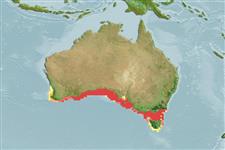Classification / Names
ชื่อสามัญ | ชื่อพ้อง | Catalog of Fishes(สกุล, ชนิด) | ITIS | CoL | WoRMS | Cloffa
>
Perciformes/Scorpaenoidei (Scorpionfishes) >
Neosebastidae (Gurnard scorpionfishes)
Etymology: Maxillicosta: Latin, maxilla = jaw + Latin, costa, -ae = rib or rib like parts (Ref. 45335); meridianus: Name from Latin 'meridianus' meaning southern, referring to the southern distribution..
More on authors: Motomura, Last & Gomon.
Environment: milieu / climate zone / depth range / distribution range
นิเวศวิทยา
เกี่ยวกับทะเล,น้ำเค็ม สัตว์น้ำหน้าดิน; ระดับความลึก 10 - 137 m (Ref. 57438). Tropical
Southeastern Indian Ocean: Australia.
ขนาด / น้ำหนัก / Age
Maturity: Lm ? range ? - ? cm
Max length : 7.9 cm SL เพศผู้/กระเทย; (Ref. 57438)
Short description
สัณฐานวิทยา | ความยาวต่างๆ
This species is characterized by the following: pectoral-fin rays 21-24 (22) ; scales in longitudinal series 47-51 (49); pored lateral-line scales 27-29 (28); scale rows between last pelvic-fin ray bases 3 or 4 (3); scales above lateral line 2 or 3 (3), below 12-14 (13); scales between sixth dorsal-fin spine base and lateral line 3-5 (4); scales between last dorsal-fin spine and lateral line 4 or 5 (5); scales above lateral line behind head usually with no strong median ridge; central portion of inner ridge on ventral mandibular surface at the inner edge of dentary or closer to inner edge than to central ridge, no short ridge between posterior
portions of inner and central ridges; spinous points 0-6 on anterior margin of nasal spine, number decreasing with growth, spinous points 5-15 on entire nasal spine; spinous points 5-13 on surface of preocular spine; spines or distinct ridges absent on lateral margin of occipital pit between tympanic spine and origin of parietal spine base; ossified scale behind front edge of occipital pit between tympanic spines absent; dorsal surface of occipital pit smooth, no spines; spinous points 2 (rarely 1 or 3) at tip of upper opercular spine; posterior margin of maxilla extending slightly beyond a vertical through posterior margin of pupil; snout length 7.9-9.6 (8.6)% SL, upper-jaw length 19.1-22.2 (20.3)% SL, first anal-fin spine length 11.6-14.4 (13.1)% SL, second anal-fin spine length 18.4-22.5 (20.5)% SL, third anal-fin spine length 13.4-16.2 (14.7)% SL, and caudal-peduncle depth 7.8-9.0 (8.6)% SL; body without reticulate color pattern; caudal fin of preserved specimens usually without distinct melanin (Ref. 57438).
Observed to bury itself completely in the sand during the day, but are fully exposed at night. Prefers deeper sand channels, away from rubble or seagrasses (Ref. 57438).
Life cycle and mating behavior
วัยเจริญพันธุ์ | การสืบพันธุ์ | การวางไข่ | เซลสืบพันธ์ของเพศเมีย(ไข่) | ความดกของไข่ | ตัวอ่อน
Motomura, H., P.R. Last and M.F. Gomon, 2006. A new species of the scorpionfish genus Maxillicosta from the Southeast coast of Australia, with a redescription of M. whitleyi (Scorpaeniformes: Neosebastidae). Copeia 2006(3):445-459. (Ref. 57438)
IUCN Red List Status (Ref. 130435)
Threat to humans
Harmless
Human uses
ข้อมูลเพิ่มเติม
ชื่อสามัญชื่อพ้องกลไกการเผาผลาญพลังงานผู้ล่าการศึกษาเกี่ยวกับผลกระทบของสารประกอบทางเคมีที่เป็นอันตรายต่อสิ่งมีชีวิต ประชากร และสิ่งแวดล้อมการสืบพันธุ์วัยเจริญพันธุ์การวางไข่การรวมกลุ่มวางไข่ความดกของไข่เซลสืบพันธ์ของเพศเมีย(ไข่)Egg development
Age/SizeการเจริญเติบโตLength-weightLength-lengthLength-frequenciesความยาวต่างๆสัณฐานวิทยาตัวอ่อนพลวัตของสัตว์น้ำวัยอ่อนการทดแทนที่อุดมสมบรูณ์BRUVS
อ้างอิงการเพาะเลี้ยงสัตว์น้ำประวัติการเพาะเลี้ยงสัตว์น้ำสายพันธุ์พันธุศาสตร์ElectrophoresesอัตราพันธุกรรมโรคการแปรรูปNutrientsMass conversion
ผู้ร่วมมือรูปภาพหลายรูปStamps, Coins Misc.เสียงปลามีพิษ เช่น ปลาปักเป้าความเร็วรูปแบบการว่ายน้ำพื้นที่เหงือกOtolithsสมองวิสัยทัศน์
เครื่องมือ
Special reports
Download XML
แหล่งที่มาจากอินเตอร์เน็ต
Estimates based on models
Preferred temperature (Ref.
123201): 14.3 - 18.2, mean 16.7 °C (based on 124 cells).
Phylogenetic diversity index (Ref.
82804): PD
50 = 0.5156 [Uniqueness, from 0.5 = low to 2.0 = high].
Bayesian length-weight: a=0.01000 (0.00244 - 0.04107), b=3.04 (2.81 - 3.27), in cm total length, based on all LWR estimates for this body shape (Ref.
93245).
ระดับชั้นอาหาร (Ref.
69278): 3.4 ±0.5 se; based on size and trophs of closest relatives
Fishing Vulnerability (Ref.
59153): Low vulnerability (10 of 100).
